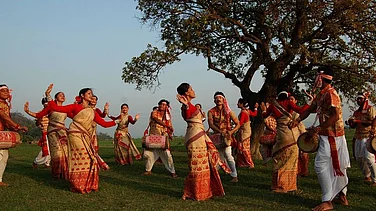The nine-day Hindu festival, Navratri holds a special place in the hearts of Indians with its unique rituals and religious significance this festival is by far the most auspicious 9 day fasting festival of Hinduism. Among the many traditions that hold deep sacred values during Navratri, Kanya Poojan also known as Kanya Poojan is one of them. Performed on Ashtami (eighth day) and Navami (ninth day) of Navratri, the tradition is of worshipping young girls as the embodiment of Goddess Durga. Familiar to many and unique as its practices are, it holds a special religious sentiment with its proceedings.
The Significance of Kanya Poojan
Feeding everyone’s curiosity, it is intriguing to know how this religious practice holds a special place and has been retained as a respectful ritual that people entertain with great respect. As per Devi Puran, this ritual is in place to show devotion towards Goddess Durga, who can be greatly pleased with the devotees who perform this practice and hence bestows her blessings upon those who perform it.
The Rituals of Kanya Poojan
Young girls aged anywhere from one to ten are invited to one’s house welcomed as a representation of religious deities. The custom is to be a host to four to nine girls, each one of them being considered a form of Goddess Durga. The children are welcomed by washing their feet with milk, water, and flowers. Once they enter the place, they are respectfully served with the customary meal of the Navratri, Prashad. This meal consists of fruits, poori, halwa, chane, and coconut, accompanied by offerings and gifts. This customary meal is only consumed by the hosts and their families once the Kanya Poojan has taken place and the children have consumed their meals, a common practice in Hinduism of offering fresh food to god before consumption.
The Age of the Girls and Their Symbolism
It is also crucial to note that during Kanya Poojan, the age of each girl holds a special significance hence creating a captivating differentiation.
A two-year-old is believed to be the one who eliminates poverty and sorrow
A three-year-old (also considered Trimurti) - Brings happiness and prosperity
A four-year-old – Carries welfare to the family
A five-year-old called Rohini repels illness of all kinds
A six-year-old girl is considered a form of Kalinka who blesses with knowledge and Victory
A seven-year-old in the form of Chandika draws wealth to the household
An eight-year-old is called Shambhavi who leads to victory
A nine-year-old (called Durga) – Defeats enemies and completes tasks.
A ten-year-old girl who is also considered as Subhadra fulfills the wishes of the devotee
The Rules of Performing Kanya Poojan
Concerning the sacred nature of the ritual, some specific rules are followed strictly while performing Kanya Poojan. The invitation has to be given one day before the ritual, and on the day itself, the first and foremost step has to be worshipping Mother Goddess followed by feet washing of the invited children. Once the children are seated properly, Raksha Sutra is tied on their wrists, and tika is applied to their forehead. All the Food is offered to the deity before serving it to the children, and a pooja ceremony also takes place in everyone’s presence.
Kanya Poojan is a beautiful and meaningful ritual during Navratri, symbolizing the worship of the divine feminine. It is a time to honor and celebrate young girls, seeking their blessings and nourishing them with love and respect. By following the traditions and rules of Kanya Poojan, one can invite the blessings of Maa Durga and promote prosperity, happiness, and well-being.



























